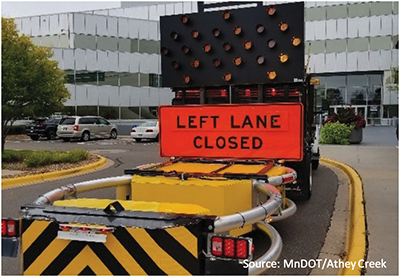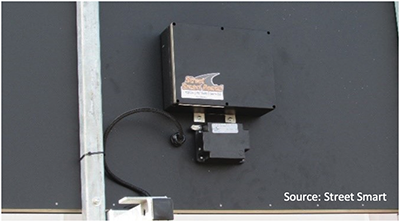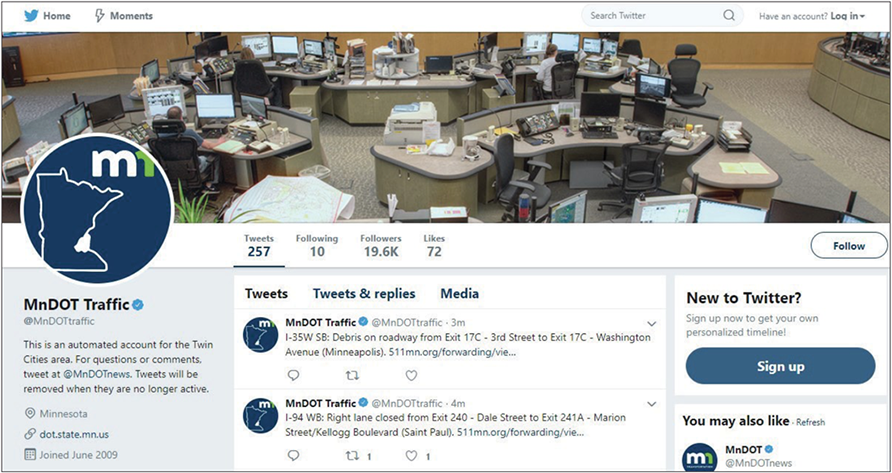Real-Time Integration of Arrow-Generated Work Zone Activity Data into Traveler Information Systems
Printable Version [PDF, 1.3MB]
You may need the Adobe® Reader® to view the PDFs on this page.
Contact Information: Operations Feedback at OperationsFeedback@dot.gov

U.S. Department of Transportation
Federal Highway Administration
Office of Operations
1200 New Jersey Avenue, SE
Washington, DC 20590
ops.fhwa.dot.gov
June 2019
FHWA-HOP-19-050
The Minnesota Department of Transportation is Using Connected Arrow Boards to Improve Traveler Information and Lane Closure Information Accuracy
Project Overview
The Minnesota Department of Transportation (MnDOT), as part of the ENTERPRISE Pooled Fund Study, is implementing a Smarter Work Zone Technology Application that utilizes real-time work zone activity information to improve situational awareness for operators to monitor traffic operations and automatically create lane closure notifications for the public in 511.

MnDOT Maintenance Truck used during the Connected Arrow Board Pilot Project
Installed devices on portable arrow board displays gather and communicate lane closure status data from stationary and rolling work zones of short duration maintenance activities. Lane closure status information is integrated into two of MnDOT's existing systems: the State's Advanced Traffic Management System (ATMS) and the Road Condition Reporting System (RCRS), both managed and operated by the Regional Traffic Management Center (RTMC). The outcome from this integration will result in the communication of real-time traveler information to the public, both through dynamic message signs (manually) and the State's 511 system (automatically). The system will also allow MnDOT to monitor and evaluate work zone performance measures using the available lane closure data.
Starting in April 2018, MnDOT tested the integration of lane closure messages from 20 connected arrow boards and their ATMS and RCRS systems during a one-year testing period in the Minneapolis/St. Paul metropolitan area. This deployment is part of the ENTERPRISE Pooled Fund Study vision to procure State and local systems that follow common requirements and meet existing and future traveler information needs.
Current Challenges

Arrow board monitoring unit on the back of a MnDOT arrow board
Current MnDOT traveler information tools, including permanent dynamic message signs (DMS) and 511, do not incorporate real-time work zone lane closure information. What reporting of lane closures information from the field does occur is often inaccurate or untimely due to challenges in knowing when work will take place, and it often being viewed as a low priority or adding additional work for construction and maintenance staff. Additionally, MnDOT has no existing technology or equipment that communicate real-time work zone activity data to a central information system. As a result, detailed real-time information such as location and timing of work zone activities is missing from traveler information systems.
Additionally, the lack of accurate real-time and historical work zone activity data has hindered the agency from monitoring and evaluating its ability to actively manage the safety and mobility impacts of construction activities.
Goals and Objectives
The deployment of the connected arrow boards and their integration with MnDOT's traveler information systems has the following goals:
Improve data completeness, accuracy, and reliability of real-time work zone lane closure information.
The connected arrow board system will enable complete, accurate, and reliable reporting of real-time work zone lane closure information through the automatic reporting of the system's operational status, including:
- Activation status
- Facing direction
- Activated arrow direction
- Location (roadway, milepost, coordinates)
- Time
This automatic and integrated stream of work zone activity data will allow MnDOT and TMC operators to monitor, assess, and archive work zone activities across the Twin Cities metro area.
Improve lane closure traveler information dissemination and reporting.
The timely and accurate dissemination of lane closure information can assist with trip planning and facilitate alternate route selection by users, reducing congestion associated with roadway construction. Once automatically ingested into MnDOT's RTMC, accurate and timely lane closure information will be pushed to both TMC operators and the State's Intelligent Roadway Information System (IRIS). This integration will enable TMC operators to post lane closure information on DMS located upstream of the closure, and automatically disseminate the lane closure information to the State's 511 web system and mobile application.
In order to assess the effectiveness of this information dissemination, an evaluation team will conduct a qualitative assessment of the events reported by the Arrow Board Reporting System. In addition to surveying traveler information system managers and operators on the added value of accessing updated information, public opinion will also be evaluated using posted polls on MnDOTs traveling information website. This public evaluation will help MnDOT to understand how lane closure information affects travelers' trip planning and route choices.

Right lane closure on Minnesota's Twitter feed, driven by Smart Arrow Board
Source: Athey Creek
Maintain a sustainable information system for performance management.
The ability of the system to store raw and processed arrow board lane closure data with timestamps, status changes, and locations creates an opportunity to improve planning, managing, and maintaining the current transportation systems. Making lane closure information available to other MnDOT departments as well as stakeholders and researchers will help identify the evaluation measures, data needs, and data analysis methods necessary for tracking operational performance effectively and efficiently.
The figure below shows how lane closure information will flow across MnDOT systems, culminating in an increase in high quality lane closure information and better dissemination of lane closure information thorough DMS and other traveler information systems.

Traveler Information Collection, Integration and Dissemination Flowchart
System Overview
As illustrated in the figure on Page 4, the continuous operation of a system that unifies, integrates and streamlines compatible real-time work zone status includes: field deployment, vendor-hosted server, and MnDOT Systems for information integration and data archive.
Existing truck-mounted arrow boards used for short-duration work zones and maintenance activities will be equipped with an Arrow Board Reporting System. This system will consist of a physical device attached to the arrow board with wireless communications capabilities and a power source. When the arrow board is turned on by maintenance staff, work zone related information is automatically communicated to a vendor-hosted server. The message to the server contains an identification number for the device with location data, timestamp, and arrow display status (left/right, activated/deactivate).
The vendor-hosted arrow board server is responsible for calling information from the arrow board every two minutes and to create an incident event automatically that will be ingested by IRIS. In this manner, if there is a change in arrow board status, a new incident ID will be created using the same arrow board device ID. The vendor-hosted server will remove information from the incident feed when the arrow board is deactivated.
The incident feed generated by the vendor-hosted server is connected to the State's IRIS system. IRIS processes information and either creates a new incident or updates an existing incident based on information received through the incident feed. IRIS automatically alerts the regional traffic management center (RTMC) operators of any new or ongoing active lane closure. The RTMC operator uses the IRIS map interface to observe lane closure information and visually verifies closure using a nearby camera if available. The RTMC operator can update traveler information message on upstream CMS/PCMS if one is present. All incident-related data is automatically archived in the IRIS Data Archive. When the arrow board is deactivated, given the absence of incident ID from the incident feed, IRIS will close the incident.
IRIS automatically feeds information into MnDOT's Condition Acquisition and Reporting System (CARS). CARS automatically processes lane closure event information from IRIS and either creates a new CARS event or updates an existing event. Event information is automatically posted and made available to travelers via the State's 511 website and mobile application. When the arrow board is deactivated, the CARS event is closed and 511 is automatically updated.

MnDOT's Operational System for Traveler Information using Arrow Boards
Estimated Costs
The estimated costs of the MnDOT connected arrow board deployment are provided in the table below. The primary cost associated with the connected arrow board deployment is in the rental of the Arrow Board Reporting System. These vendor-owned systems, including the vendor-hosted server, are rented from the vendor at a per-month, per-device cost. This rental fee includes arrow board installation and the periodic maintenance and inspection of the reporting systems. The cost of the arrow boards is not included in the cost estimate provided in the table below.
In addition to the rental fees associated with the reporting system, an estimated one-hour per device per month is estimated for MnDOT maintenance staff for inspection. While the rental fees include the vendor-hosted server, an estimated 8 hours per year is estimated for the routine maintenance of arrow board connectivity to IRIS and CARS. The below cost information does not account for staff hours initially required for MnDOT to integrate the connected arrow board functions within IRIS and CARS. This one time activity, once complete, can be leveraged for future larger-scale deployments. Additionally, the below estimate reflects the costs associated with a small-scale pilot activity. It is anticipated that the per-unit cost of deploying a connected arrow board system would decrease with future, larger-scale deployments.
| Cost Item | Hours of Staff Time | Annual Estimated Cost |
|---|---|---|
| 20 Arrow Board Reporting Systems | - | $14,400 ($60 /month/device) |
| MnDOT Maintenance Staff | 1 hour/device/month | $1,200 |
| Routine Maintenance of Arrow Board functions in IRIS | 8 hours/year | $480 |
| Routine Maintenance of Arrow Board functions in CARS | 8 hours/year | $480 |
| Total $16,560 |
For more information on MnDOT's use of connected arrow boards, contact Daniel Rowe (Daniel Rowe@state.mn.us).
Additional resources on SWZ Performance Measurement can be found at: www.workzonesafety.org/swz
For additional information, please contact the FHWA Work Zone Management Program: WorkZoneFeedback@dot.gov
